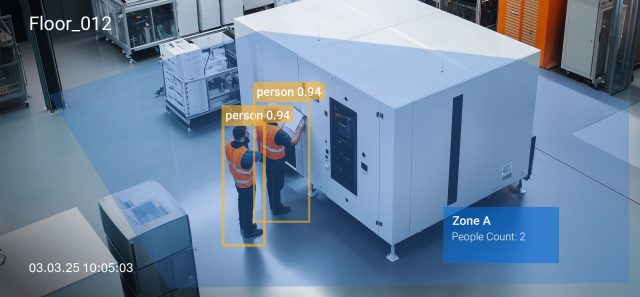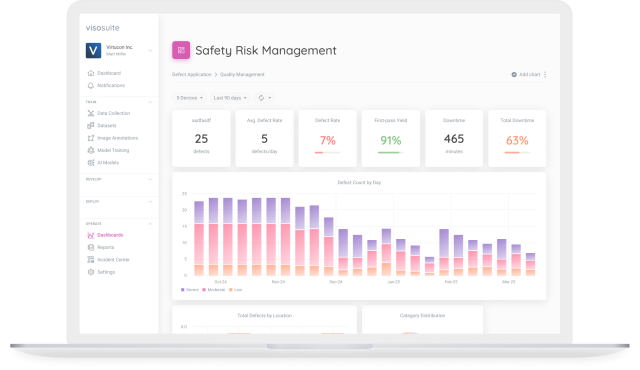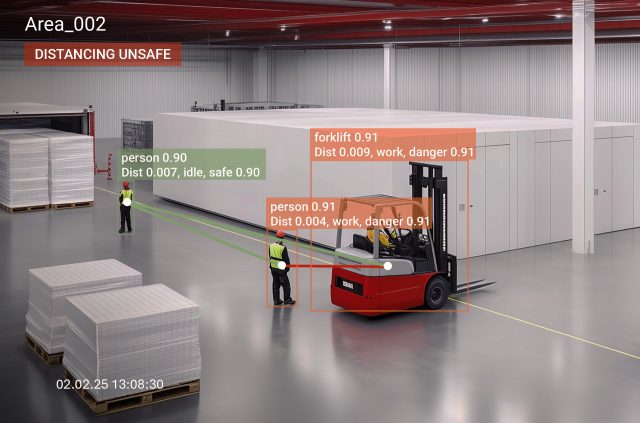Driving safety: key insight
Computer vision (also known as Vision AI) radically improves driving safety and prevents accidents. It facilitates safe driving by enabling real-time detection of speeding vehicles, unsafe proximity, and zone intrusions. Above all, Vision AI can trigger automated alerts before incidents can escalate into harm.
Why safe driving matters
As Vision AI prevents accidents instead of merely reacting to them, organizations significantly reduce injuries and fines. This ensures greater uptime, operational continuity and workforce protection through improved driving safety.

Rethinking driving safety in the age of automation
In industrial environments where heavy machinery, moving vehicles, and high throughput define day-to-day operations, driving safety simply cannot be an afterthought. However, in many facilities, safety practices are still rooted in reactive, manual approaches. They rely heavily on human oversight, scheduled audits, and post-incident reporting.
While traditional safety protocols are well-intentioned, they often leave critical gaps. Frequently, near misses may go unnoticed or unreported, and for the most part, unsafe behaviors are typically only addressed after an accident has occurred.
In an era where operational resilience and workforce wellbeing are strategic imperatives, this model is no longer sustainable. Enter Vision AI, offering real-time, proactive monitoring that enables safety teams to prevent incidents before they happen.
Quantifying the impact of poor driving safety
Forklift mishaps alone cause substantial harm and damage. The Wall Street Journal reports that every year in the US, around 7,500 workers are injured and nearly 100 are killed through forklift-related incidents. Globally, anywhere from 35,000 – 62,000 injuries have occurred annually over the last decade due to poor driving safety with forklifts, where up to half can have a severe and enduring impact.
The high risk of collisions with pedestrians on site is also a key consideration. An estimated 30% of forklift accidents happen in warehouses, with 36% of associated fatalities involving pedestrians. There is a significant resulting financial burden per incident, and each forklift accident can cost as much as $135,000 in direct damages (plus $38,000 in indirect costs for lost workday injuries).
High injury and fatality rates demand proactive risk mitigation to protect employee welfare. However multiple accidents have a major operational impact, severely eroding already under pressure profit margins.
The compliance impact is also considerable. Previously, frequent pedestrian collisions and fatalities amplified legal risks and eroded trust with regulators, organizations and teams. This underscores why AI-powered Vision systems – capable of detecting speeding vehicles, unsafe proximities, and intrusions, all in real time – are markedly invaluable. By enabling proactive alerts before events escalate, they not only save lives but also deliver cost savings and operational resilience.

From passive observation to active prevention
Vision AI leverages existing video infrastructure and computer vision algorithms to actively detect and respond to risks. Unlike conventional CCTV systems, which function primarily as forensic tools, Vision AI significantly delivers immediate, automated alerts when unsafe conditions emerge.
For example, if a forklift exceeds a safe speed limit, or enters a pedestrian-designated zone, the system detects the breach in real time and notifies supervisors. Similarly, if workers or vehicles access restricted zones, these violations are flagged instantly, enabling prompt intervention and course correction.
When this predictive capability transforms safety operations from a reactive response into a proactive shield, then the impact is measurable:
- Vehicle speeding and proximity violations reduced by over 60%
- Forklift collisions cut by up to 50%
- Blocked emergency exits detected and cleared before regulatory exposure
- Insurance claims lowered due to fewer incidents and enhanced documentation
Each avoided collision saves thousands of dollars in equipment repairs, administrative investigations, and worker compensation. Crucially, by safeguarding the wellbeing of employees, it reinforces a culture of accountability, loyalty, and operational pride.
Smarter driving safety, stronger performance
Beyond individual events, Vision AI brings a systems-level competitive advantage.
By continuously scanning operational environments 24/7, it compiles dynamic logs of safety-related incidents, each time-stamped and categorized for review. This wealth of contextual data enables EHS leaders to identify risk-prone areas, analyze incident trends, and pinpoint recurring compliance gaps.
Vision AI elevates safety reviews from anecdotal debriefs to evidence-backed strategies. Specifically armed with insights, leaders can develop targeted training, reinforce high-risk protocols, and measure the effectiveness of interventions with clarity.
Vision AI also changes the questions that safety leaders ask. Instead of “What went wrong?” the focus shifts to “Where are we vulnerable?” and “What can we prevent today?”
This radical shift in perspective drives continuous improvement and cultivates an anticipatory safety culture: one that actively seeks to eliminate risk at the source.

Accelerating the path to zero harm with safe driving
One of the most powerful aspects of Vision AI is its practicality. Generally deployment is fast and adaptable, with most organizations able to move from assessment to operational rollout in under twelve weeks.
It works seamlessly with existing camera systems and integrates into existing EHS and manufacturing workflows, minimizing technology and implementation challenges and change management complexity.
A phased approach allows companies to start small – targeting a single high-risk loading bay, for example – and scale as results materialize. Meanwhile this flexibility reduces investment barriers, allowing leaders to demonstrate early wins and secure buy-in for broader implementation.
What was once a theoretical aspiration – preventing incidents in real time – is now a strategic reality that can be piloted, scaled, and proven with measurable outcomes.
Final thoughts: the future of industrial safety is preventative
In safety, timing is everything.
The ability to detect, alert, and respond to hazards in real time is fast becoming a baseline expectation, not a futuristic aspiration. Vision AI gives safety leaders the tools to lead with insight, act with precision, and protect with confidence.
It removes blind spots, reduces administrative burdens, and provides a digital layer of intelligence that strengthens the entire fabric of operations.
For industries facing tighter compliance, shrinking margins and a mandate to protect both people and performance, Vision AI is no longer a tool: rather it’s the most effective strategy. Specifically, one that turns everyday video data into a powerful asset for safety, efficiency, and long-term value.
In the end, the goal remains simple however, to ensure every shift ends the way it should: safely.
Vision AI is already preventing accidents before they happen, and adoption will only serve to further address driving safety improvements in the years to come.
